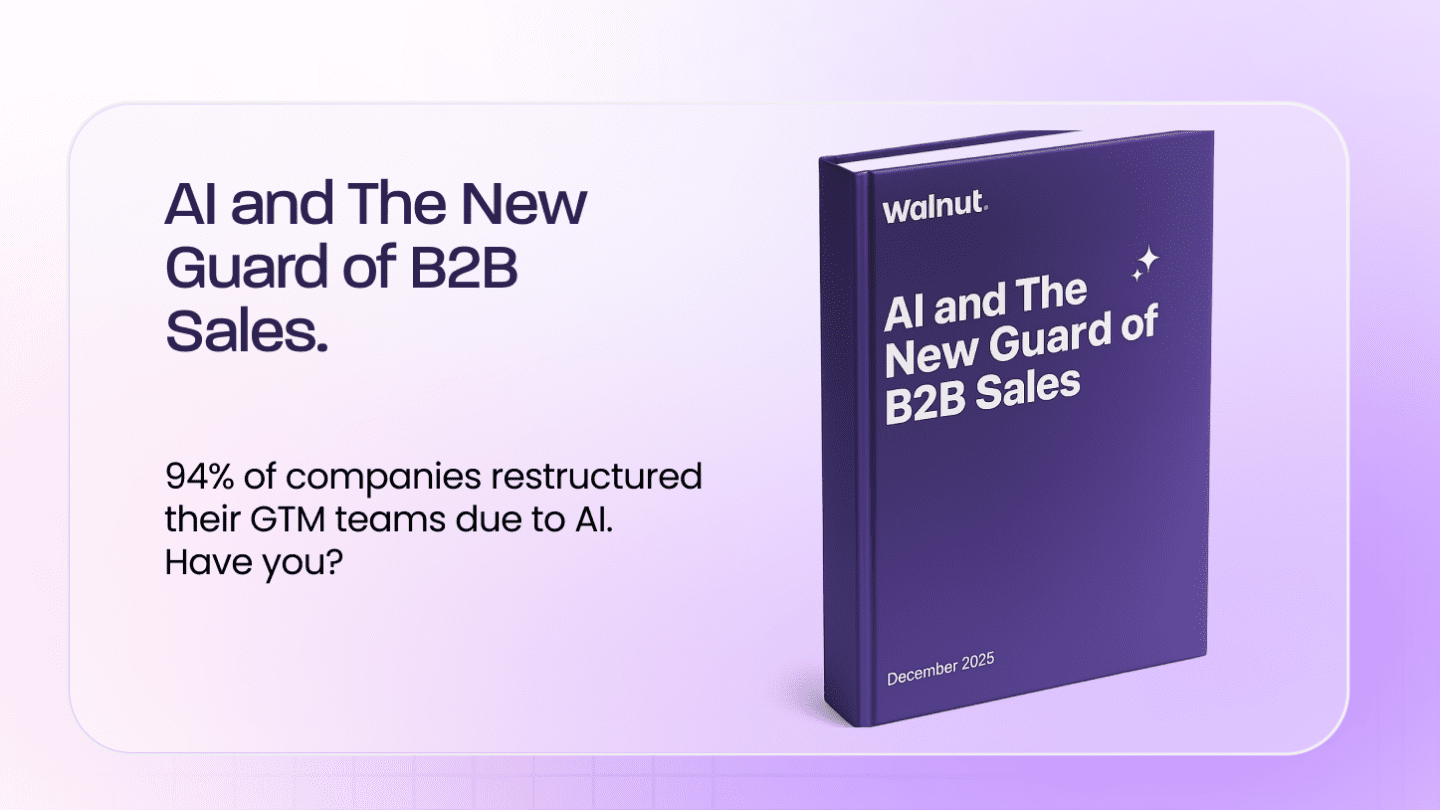Two heads, they say, are better than one. This is especially true with B2B organizations, where it sometimes takes up to 10 decision makers (or heads) to make a buying decision.
Considering this change happening in the B2B SaaS sales process, salespeople must learn how to build a relationship with multiple contact points at the companies they’re trying to sell their products or services to.
Unfortunately, only a few companies and sales teams follow the multi-threaded sales path, as 78% of sales professionals still stick to the traditional single-threaded sales approach.
However, sales multi-threading trumps single-threading and this definitive guide will show you why.
What is sales multi-threading?
Sales multi-threading is the simultaneous and deliberate effort to build sales conversations and relationships between your sales team and as many key decision makers from the company (or companies) you’re trying to sell to.
Suppose your sales team is selling your product to another organization. In that case, sales multi-threading will mean that your sales team often talks with specific stakeholders involved in the buying process in the buying organization.
In multi-threading, you get multiple people at your organization talking to other people at your prospective client’s organization.
How is this different from single-threaded sales?
In single-threaded sales, you cultivate a one-on-one relationship with the buyer. This classic dynamic involves a sales rep handling the client with a single contact. However, instead of involving multiple people on both ends, it involves just two people.
So, is multi-threading (having several connections with a client) better than single-threading (having a single contact with a client)?
One way to answer that is by considering the advantages of a multi-threaded approach to sales.
Benefits of sales multi-threading
Here are some reasons why you should ditch single-threaded sales and adopt a multi-threaded sales approach.
Multi-threading closes deals
Arguably the single most significant advantage of sales multi-threading is that your biggest deals are not going to be closed without it.
While you might be able to close some deals with the single-threaded approach, the big deals — the ones that would move the needle for your business — often require more than one person making the decision. Don’t forget that buying decisions in B2B companies often involve 6-10 stakeholders.
Rein in your skepticism for a minute and think about how things are run in your own company. How do deals get closed? Who’s involved in your company’s purchasing decisions? Unless your company is a one-person team, multiple people from different levels of your organization are interested in buying a product. While there might be a key decision-maker, this person often consults with others before making purchases—especially significant ones.
Why should it be any different with your potential clients?
When you contact all or most of these key decision-makers, you have a higher chance of closing deals.
Multi-threading helps you beat turnover
To paraphrase Thanos from The Avengers: “Dread it, run from it, employee turnover arrives just the same.” Every company experiences employee turnover—it’s inevitable. However, one of the most significant benefits of having a multi-threaded sales approach is that you can reduce the chances of employee turnover destroying your deals.
The average annual turnover rate across industries is 19%, which is terrible news for organizations with a single-threaded sales approach.
If you have a single point of contact with a client, what are the chances that this contact, this champion, will be at the organization next year? If you’ve poured your heart and soul into cultivating a relationship with them, all your efforts will go down the drain when they leave.
And remember, employee turnover is not only your client’s problem—your people can leave too. So if the only point of contact your client has with you leaves, you might be left high and dry.
Thankfully, multi-threading protects you. When you’re in contact with multiple stakeholders at prospective clients, even if one of them leaves, your deal doesn’t leave with them.
Multi-threading drives improvement
Sales multi-threading reveals insights about prospective clients that you’d never have gleaned without it. In addition, since you’re in contact with several stakeholders, you gain a holistic view of potential bottlenecks—and you can adapt accordingly.
Additionally, it leads to a proactive sales team that ensures opportunities aren’t lost once the client is ready to purchase.
Single-threading vs. multi-threading
Do the advantages of multi-threading mean that single-threading has no merits? Of course not! There’s a reason why many sales professionals love single-threading—despite the risks that it poses.
Here are some advantages of single-threading.
Single-threaded sales create loyalty
A single-threaded sales approach allows a sales rep to create a stronger, loyal bond with their point of contact. This loyalty can turn this contact into a super-contact: a champion. They will champion the product and can even win critical stakeholders in their organizations.
Single-threading is simple
Single-threading is relatively simple compared to the work required to maintain multiple contact points with the buying organization.
It saves time and effort, making it easier for sales reps to add more customers to their client portfolio.
While these advantages are significant, they aren’t as substantial as the disadvantages of single-threading.
Why multi-threading is better than single-threading
Although single-threading is simple and can build stronger relationships, the risk of losing all your hard work when your champion leaves the organization is too immense a disadvantage to overlook.
Why be over-reliant on a single person when you can rely on several critical stakeholders simultaneously?
Give yourself and your organization by using a multi-threaded sales approach going forward.
Risks involved with sales multi-threading
Multi-threading only runs the risk of failing if not implemented correctly. However, you won’t have any trouble with this approach when you know and implement the best multi-threading practices.
Common multi-threading mistakes
Here are some mistakes professionals make when multi-threading.
Not multi-threading early
If you’re trying to use multi-threading to revive a deal that seems destined to fail, it most likely will not work. As much as we love the multi-threaded approach to sales, it’s not magic, and you’ll need to set the right things in place if you want to experience success with the process.
Not connecting the proper levels
It’s best to connect similar levels. People prefer to speak to those at the same level within the organization, and failure to do this might jeopardize your deal.
Not having one-on-one conversations
The goal of multi-threading is to have one-on-one conversations with each key stakeholder. Having all the stakeholders at one meeting or product demo isn’t multi-threading.
Sales multi-threading best practices
If you’re ready to close more deals and quicken your sales cycles, then follow these best practices.
- Research
It all starts with proper research.
Before you start multi-threading, it’s vital to research the organization you want to sell to thoroughly. It’s best to find out all you can about a buying company before you even approach them.
When researching, you must identify the key stakeholders in the decision-making process.
To identify the key stakeholders and build a relationship with them, you must consider the following questions:
- Who should I contact?
- Who are the decision-makers in the organizations?
- What are the roles and responsibilities of each stakeholder?
- Who else can influence whether our product is bought or not?
- What are the priorities of each stakeholder?
- What might prevent them from purchasing our product?
Research is nothing new to sales professionals, but an alarming number of professionals fail to give this aspect the attention it deserves.
- Create relationships across levels
The 6-10 people involved in making B2B buying decisions will be from different departments and levels of the organization. Thus, it’s essential to create a relationship with them once you’ve identified the key players.
CEO to CEO. C-Suite to C-Suite. VP to VP. You get the idea.
Even if you currently have one point of contact, you can leverage this connection to access others. One way to do this is to ask them who else is involved in the project. Then, once you’ve identified them, have your people reach out to them.
This now takes us to the next practice.
- Prepare your team
You don’t want to lose all the hard work you’ve done to a new or untrained team member, especially now that you have one foot in the door.
To ensure that the meetings set up with other contact points align with your sales goals, you’ll need to prep your team members. Also, provide your members with the research you’ve done, including the goals and priorities of the contact.
Have regular internal meetings with representatives and managers to keep everyone on the same page. While you try to ensure that no member of your team misses any meetings, it’s a good idea to prepare recordings of your meeting that’ll keep absentees looped in.
- Stay informed
Change is constant, and organizations evolve. Therefore, your sales team needs to stay informed of any changes at buying organizations. Promotions, turnover, new hires, funding rounds, branch openings, and general news are some of the changes that can lead to a shift in priorities.
When you’re in the loop, you can make the right decisions based on these changes.
- Stay in touch with your first contact
Just because you’ve gotten people higher up the chain of command doesn’t mean you should throw away the person that got you through the door.
Ditching them will be rude, making it look like you’re merely using them. And it can foil your plans to close a deal (you might be surprised what they can do if they feel slighted).
Therefore, it’s wise to keep communication lines open. What if you don’t know what to say to them? Well, you can always keep them in the loop on any progress made or give them tips on how to get the best from your product once the deal is closed.
Best tools for sales multi-threading
The more points of contact you have, the better. You must use the best tools to make it easy to connect with these contacts and keep them.
Here are some of the best tools for sales multi-threading.
- LinkedIn Sales Navigator
You need to find the right people to connect with, and LinkedIn Sales Navigator helps you to do just that. This tool allows you to use advanced search to find the executives relevant to you.
- Walnut
The main goal of multi-threading is to set up one-on-one demo conversations with stakeholders in the buying organization. So naturally, you’d need a tool that’ll help you do that.
Walnut allows you to send a link to a personalized interactive demo created for each stakeholder you reach out to. Additionally, it helps you to glean insights on their usage to improve conversion.
- Voila Norbert
With Voila Norbert, you can quickly find a person’s email address, so far you have the person’s name and the company they work for. Voila Norbert also makes prospecting easier by allowing you to schedule emails and follow-ups.
Close more deals with sales multi-threading
Sales teams and organizations that embrace a multi-threaded approach will fare better than those that stick with the single-threaded system. With tools like Walnut, you can engage each decision-maker at the buying organization and win more deals. Talk to us for more information today.





